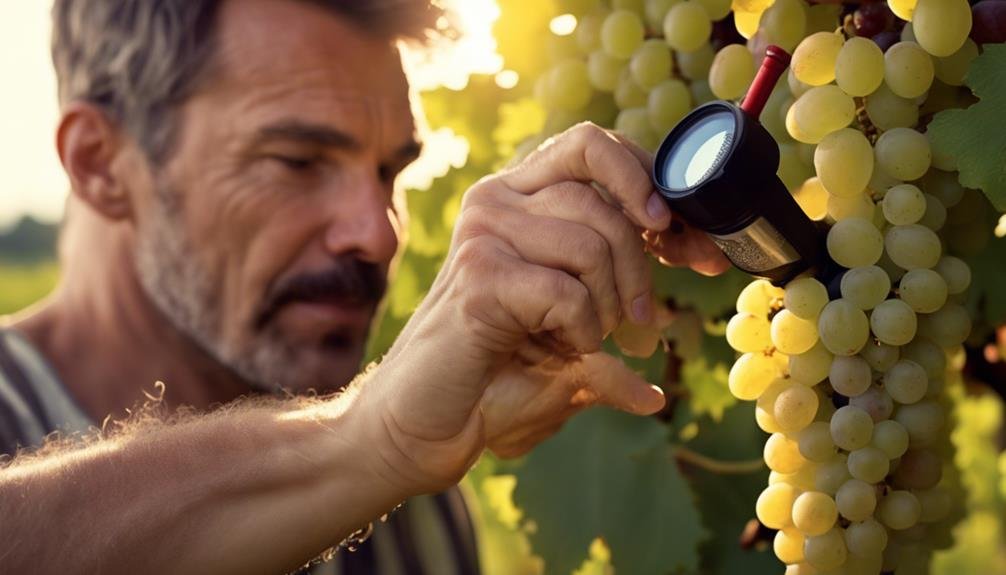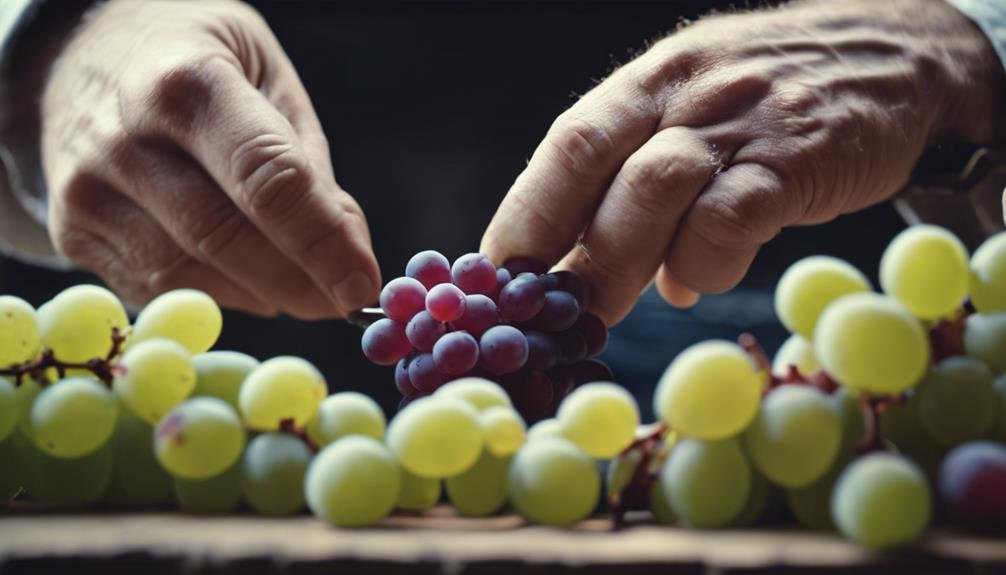Understanding the Brix measurement is crucial in winemaking, as it measures grape ripeness and potential alcohol levels. The Brix scale indicates sugar concentration in grape juice, with higher levels indicating riper grapes. This affects alcohol content, with fully ripened grapes resulting in higher alcohol levels. Brix values assist in evaluating sweetness, acidity, and alcohol balance, guiding quality decisions. The process helps evaluate grape maturity, influences harvest choices, and guarantees peak ripeness. Wine Folly highlights Brix significance in detailed wine analysis, empowering enthusiasts for well-informed wine appreciation. Discover the key to winemaking success by mastering the intricacies of Brix.
Understanding Brix Measurement in Winemaking
In the world of winemaking, understanding Brix measurement is essential for evaluating the potential alcohol content of grapes before fermentation begins. Grape ripeness, determined by sugar levels, plays an important role in this assessment.
The Brix scale indicates the sugar concentration in grape juice, assisting winemakers in predicting the resulting alcohol content post-fermentation. Higher Brix levels suggest riper grapes with more sugar, potentially leading to a higher alcohol content in the final wine. Conversely, lower Brix levels may indicate less ripe grapes with lower sugar content, resulting in a wine with lower alcohol levels.
Understanding the relationship between Brix, grape ripeness, and sugar levels is fundamental in producing wines with desired alcohol content and flavor profiles.
Correlation Between Brix and Alcohol Content
The correlation between Brix levels and alcohol content in winemaking is a critical factor influencing the final characteristics of the wine. Grape maturity, indicated by Brix levels, determines the sugar content available for fermentation, directly impacting alcohol levels.
Fully ripened grapes with higher Brix measurements tend to result in wines with elevated alcohol content. During fermentation, yeast converts grape sugars into alcohol, with each gram of sugar typically yielding about 0.5 grams of alcohol.
Factors such as grape type and yeast strain can alter this conversion rate slightly, leading to variations in alcohol content. Understanding the relationship between Brix and alcohol content is essential for winemakers to achieve the desired balance and flavor profile in their wines.
Interpreting Brix Values in Wine Production

Interpreting Brix values plays an essential role in understanding the nuances of wine production and quality assessment.
- Sugar conversion: Brix values indicate the sugar content in grapes, important for determining potential alcohol levels during fermentation.
- Grape maturity: Higher Brix levels suggest greater grape maturity, impacting the flavor profile and overall quality of the wine produced.
- Quality assessment: Interpreting Brix values helps winemakers assess the balance of sweetness, acidity, and alcohol content in the final product, guiding decisions on fermentation length and blending processes.
Understanding these aspects of Brix values allows winemakers to make informed choices throughout the winemaking process, ensuring the production of high-quality wines with desirable characteristics.
Importance of Brix Measurement Process
The Brix measurement process serves as a fundamental tool in winemaking, aiding in precise grape ripeness evaluation and guiding strategic decisions at various stages of wine production.
By measuring Brix levels in vineyards before harvest with a refractometer, winemakers can assess grape ripeness, important for making informed harvest decisions. This initial evaluation helps determine the best time to pick grapes, ensuring they are at the peak of ripeness for the desired style of wine.
Additionally, checking Brix levels again at the winery post-pressing using a hydrometer allows for the measurement of final sugar content and potential alcohol level, further influencing harvest decision-making.
Brix's Role in Wine Folly's Mission

Playing a pivotal role in wine education, Brix serves as a cornerstone metric in Wine Folly's mission to enlighten enthusiasts about the intricate world of winemaking.
- Brix Education: Wine Folly emphasizes educating on the significance of Brix in winemaking, offering insights into grape ripeness and alcohol potential.
- Wine Analysis: Through Brix, Wine Folly conducts in-depth wine analysis, delving into how sugar levels in grapes impact the final product's characteristics.
- Enthusiast Empowerment: By incorporating Brix education into its mission, Wine Folly empowers wine enthusiasts to make informed decisions about wine selection and appreciation, enhancing their overall wine experience.
Through Brix, Wine Folly not only educates but also equips enthusiasts with the knowledge needed to navigate the diverse world of wines effectively.
Frequently Asked Questions
Can Brix Values Differ Significantly Between Grape Varieties?
Brix values can vary greatly between grape varieties due to differences in grape maturity. Harvest timing and analysis play pivotal roles in understanding these variations, affecting the potential alcohol content and overall quality of the wine.
How Does Temperature Affect Brix Readings in Grapes?
Temperature affects Brix readings in grapes by influencing sugar accumulation, ripening pace, and harvest timing. Warmer climates can accelerate ripeness, potentially leading to higher sugar content, impacting fermentation and final alcohol levels in winemaking.
Are There Any Common Mistakes When Using a Refractometer?
When using a refractometer, common mistakes include inaccurate calibration and inadequate cleaning maintenance. Proper calibration guarantees accuracy in Brix readings, while regular cleaning prevents residue buildup that could skew results. Regular maintenance enhances precision.
Can Brix Measurements Help Predict Wine Aging Potential?
Brix measurements can aid in predicting wine aging potential by indicating sugar concentration pre-fermentation. Higher Brix levels suggest greater potential for flavor development during fermentation, contributing to a wine's aging capability and complexity over time.
Is There a Standard Brix Level for Optimal Wine Quality?
In winemaking, maintaining Brix consistency is crucial for peak quality. Harvesting grapes at an ideal Brix level guarantees balanced sugar content for fermentation. While no universal standard exists, aligning Brix levels with grape variety and wine style enhances overall quality.
Conclusion
To sum up, the measurement of Brix in winemaking is an indispensable tool that provides valuable insights into the potential alcohol content of wine. By understanding the correlation between Brix levels and alcohol yield, winemakers can make informed decisions at every stage of the production process.
Incorporating Brix measurement into winemaking practices is vital for ensuring the quality and consistency of wines, highlighting its significance as a key factor in the art of winemaking.
